I've always been fascinated with the zodiac, so I'm drawn to any products that feature the 12 signs. And obviously since I love makeup I have a special affinity for compacts with zodiac imagery. There's also something deeper going on – perhaps because of my ever-present need to create order out of the cluttered chaos that is my brain, I like anything calendar-related, whether it's the 12 months of the year or the 12 zodiac signs. Twelve is such a nice neat number, and each month or zodiac sign signifies a particular time of year, making it easy to recognize its passage. And January seems like a good a time to talk about the 12 months/zodiac signs as they all start in January. But enough of my ramblings and onto a very cool find. I stumbled across this while looking for vintage compacts for my own personal use (more on that next week).
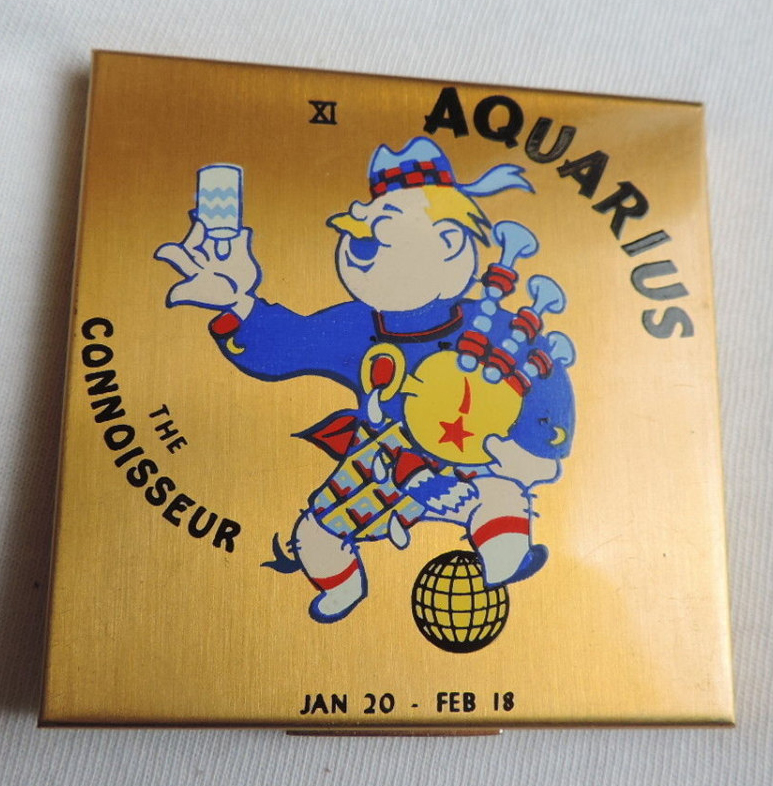
I liked the strange cartoon character representing the Aquarius sign and thought the little rhyme on the back of the compact was genius. I also appreciated both the traditional zodiac symbol above the rhyme and the corresponding element (water, earth, wind, fire) beneath – such great details. But what really caught my eye was the artist's signature on the lower right. I definitely wanted to see more work by this S. MacNiel, and I also wanted to find out how he ended up doing these illustrations for Elgin.
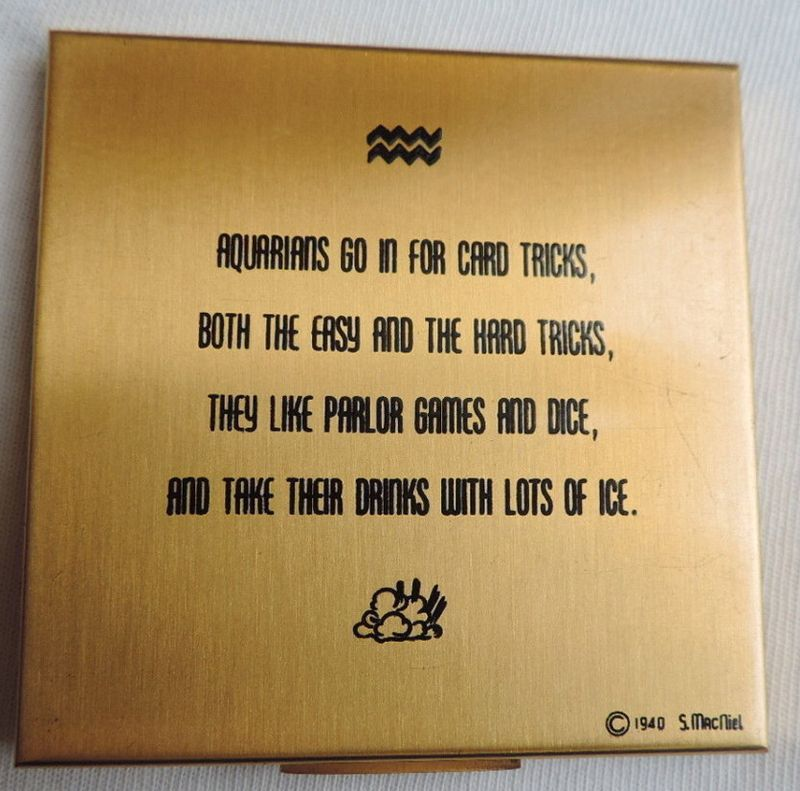 (images from etsy.com)
(images from etsy.com)
I set about finding as many images of these compacts as I could. Here's Aries:
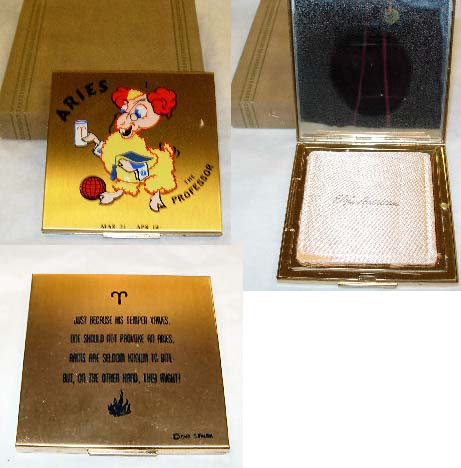
(image from onegiantyardsale.com)
Taurus:
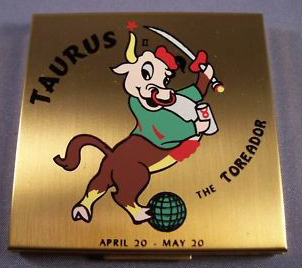
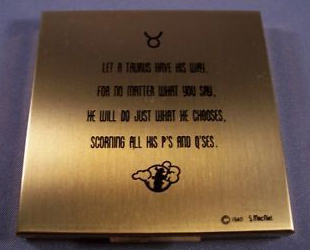
(images from worthpoint.com)
Gemini:
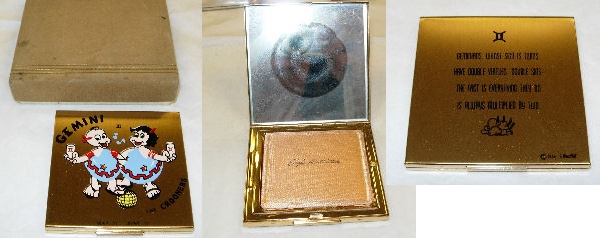 (image from onegiantyardsale.com)
(image from onegiantyardsale.com)
Cancer:

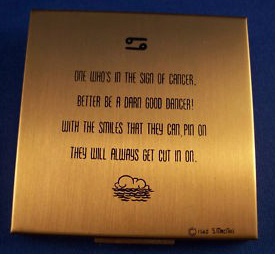
(image from worthpoint.com)
Leo:
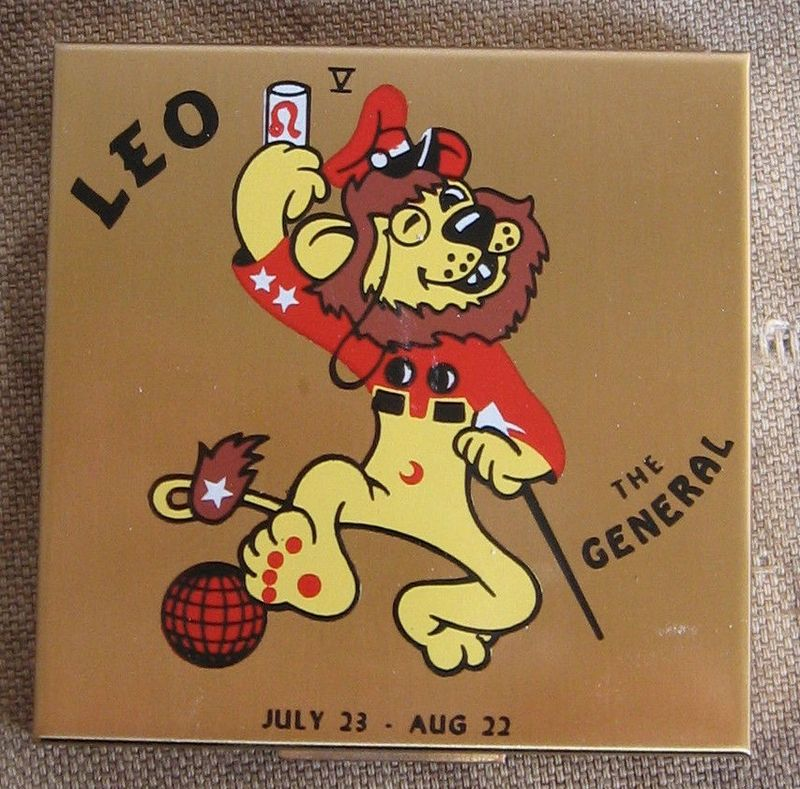
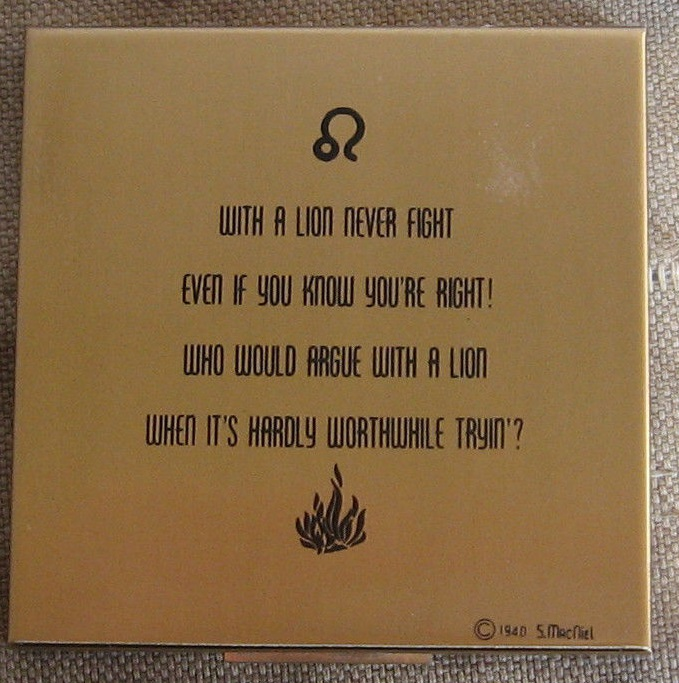 (images from ebay.com)
(images from ebay.com)
Virgo:
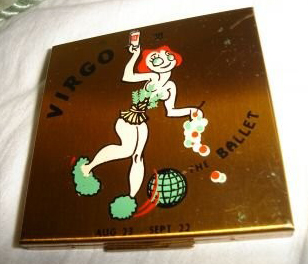
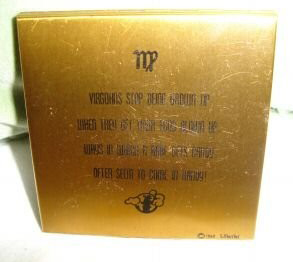
(images from worthpoint.com)
Libra – no pictures of the back, but the seller included the rhyme: "Libra people love nice things/Lollypops and diamonds rings/ They're happiest when they have bought/A lot of stuff they hadn't ought."
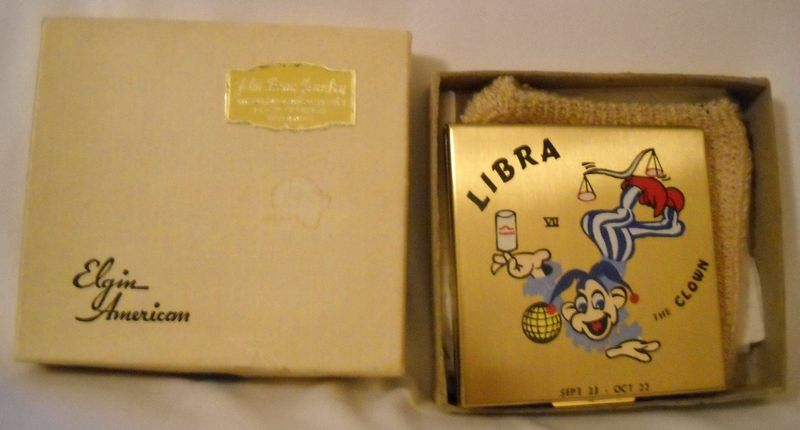 (image from ebay.co.uk)
(image from ebay.co.uk)
I couldn't find a photo of the actual compact, but here's an ad from a Pittsburgh newspaper from May 7, 1948 for Scorpio – based on the ad copy, they were playing these up as a Mother's Day gift. What I was confused about is why these were advertised in 1948 and the date near MacNiel's signature on the compact is 1940.
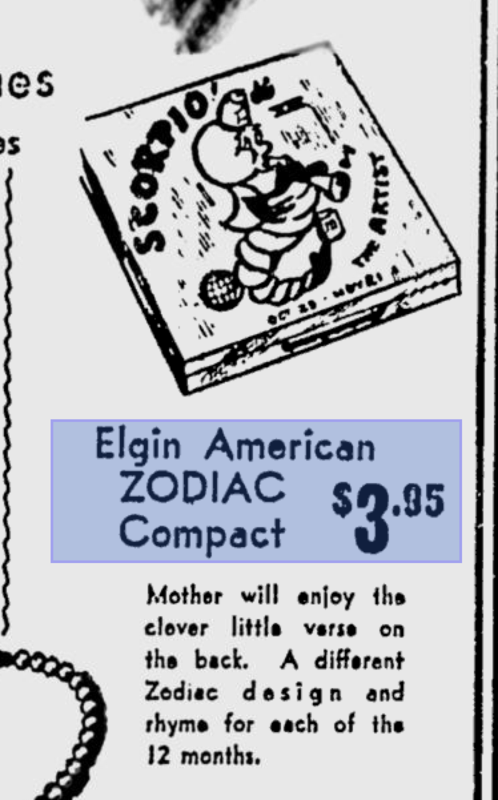
(image from news.google.com)
I was determined to reconcile the dates, so I went digging in search of information on man of mystery S. MacNiel. I found out the S. stands for Stanley, and MacNiel was a Scotsman who traveled the world but ended up in New York City. In 1940 he published a book of cocktail recipes based on zodiac signs. This wood-bound book fetches hundreds of dollars at various auction sites. The cover image is bizarre, but I have to admit quite creative. Grapes for hair, orange slices for ears, lemons for eyes, cherry nostrils, and I particularly love the way the cocktail glass becomes her mouth.
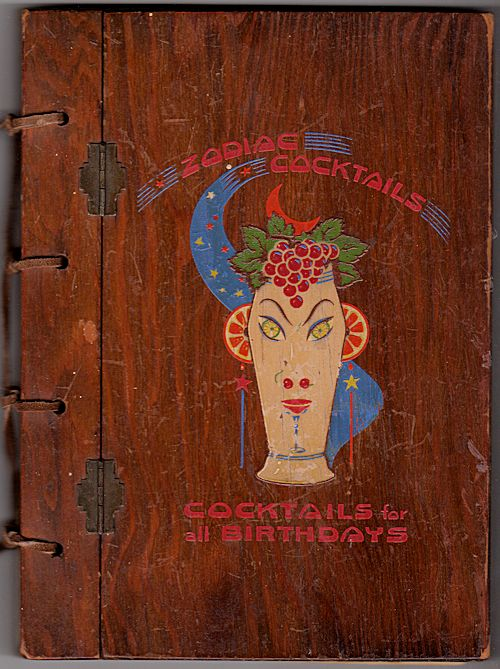
I can't believe he mentions Mussolini as a Leo of note. Uhh…
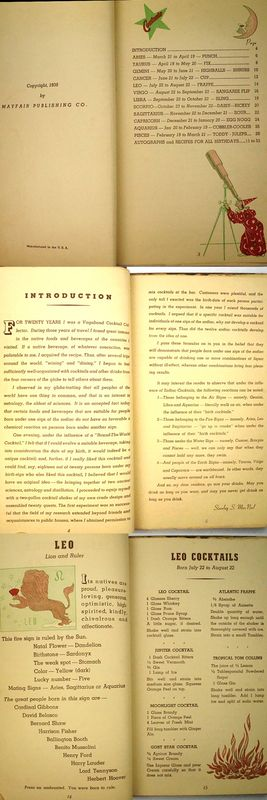
(images from read-em-again.com)
The book might not have been strange at all if our buddy Stan was a known author and artist, but he didn't seem to have a defined career. He was described as a "lecturer and leader of the Ambassadors of Good Cheer," whatever that is. (I googled and didn't find much – may have been something alcohol-related.) The book's introduction doesn't give much of an idea of what he actually did for a living either. MacNiel says, "For twenty years I was a Vagabond Cocktail Collector. During those years of travel I found great interest in the native foods and beverages of the countries I visited. If a native beverage, of whatever concoction, was palatable to me, I acquired the recipe. Thus, after several trips around the world, 'wining', and 'dining', I began to feel sufficiently well-acquainted with cocktails and other drinks from the four corners of the globe to tell others about them." So he's very well-traveled, but what did he actually do? How did he get into illustration and design? I do like the title of "vagabond cocktail collector" though. That must have been a pretty sweet gig.
Anyway, equally peculiar was MacNiel's creation of a very ornate jeweled brooch in the shape of the head of the "fruit lady" that appears on his cocktail book's cover. I don't know why the patent spells his name incorrectly. I also have no idea why he made this piece of jewelry.
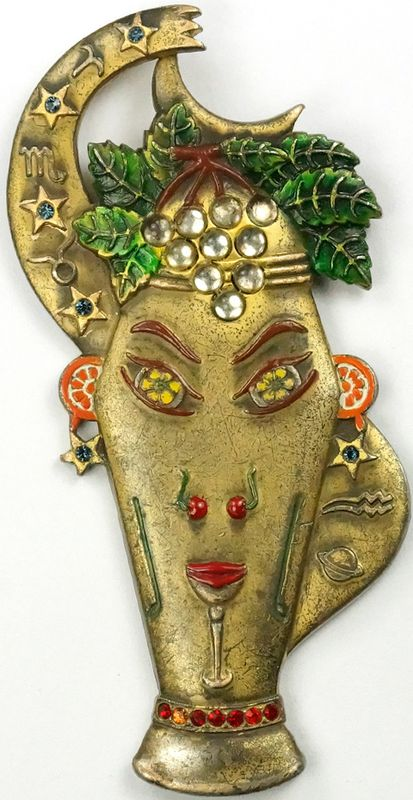
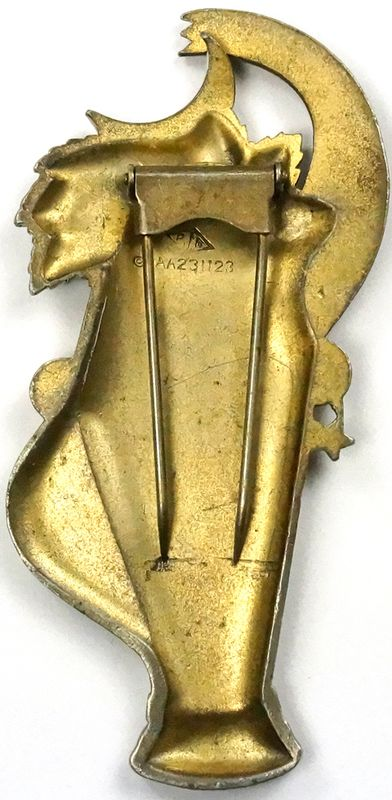
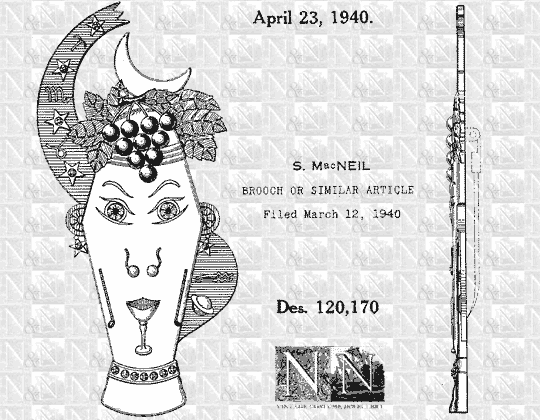 (images from trifari.com)
(images from trifari.com)
The brooch (a.k.a. a "fur clip" – fancy!) was apparently sold at Saks in New York and, like MacNiel's book, sells for hundreds of dollars.
So that's interesting, but what does all this have to do with the compacts? And what about the fact that the book was released in 1940 and the compacts seemingly weren't released until 1948? Well, here's the connection: the same rhymes that appear on the back of the compacts are in the book under each sign. The illustrations are different but the rhymes are the same. Compare the rhyme at the bottom of this page with the Virgo compact above.
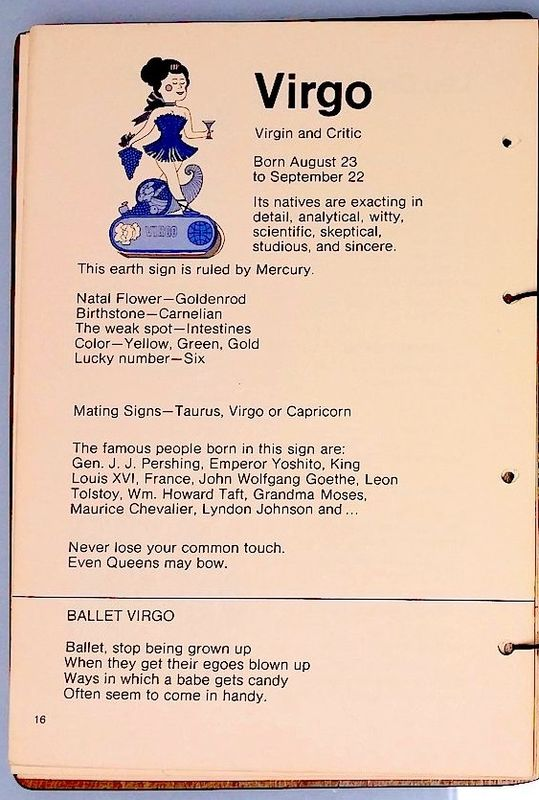
(image from winkbooks.net)
So my best guess is that he patented everything in 1940 (see his copyright for "Zodiac Humor" that year) and in 1948 allowed use of his illustrations and rhymes for the compacts, so they weren't created specifically for Elgin. Also, he lent his work not only to Elgin, but to several other endeavors as well: tiles (that could be used as trivets or wall decorations), cocktail glasses and napkins. This article in a Brooklyn newspaper from April 15, 1948 sheds a little light on the various zodiac collections, but still doesn't explain what Mr. MacNiel did for a living other than he was a "man of varied careers". It does mention that he once hiked across the entire U.S. in 90 days and took credit for introducing mens' shorts as casual wear in the States. Near as I can figure, given these facts and his seemingly endless globe-trotting, he was simply a nomadic (possibly often drunk) jack of all trades who wasn't content doing one thing or being in one place very long. (Why is his name is spelled wrong again?)
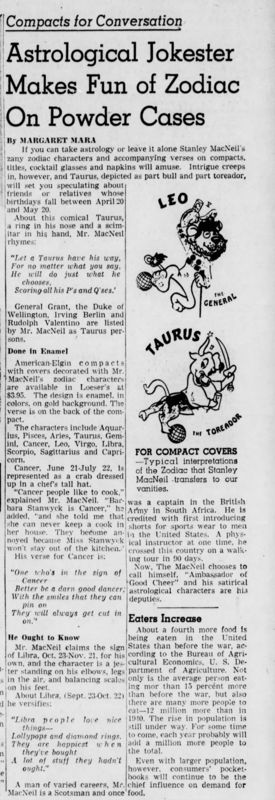
(image from newspapers.com)
Additionally, it looks like in 1953 MacNiel licensed his images to be used for a set of mugs produced by a ceramics company called Rossini Japan.
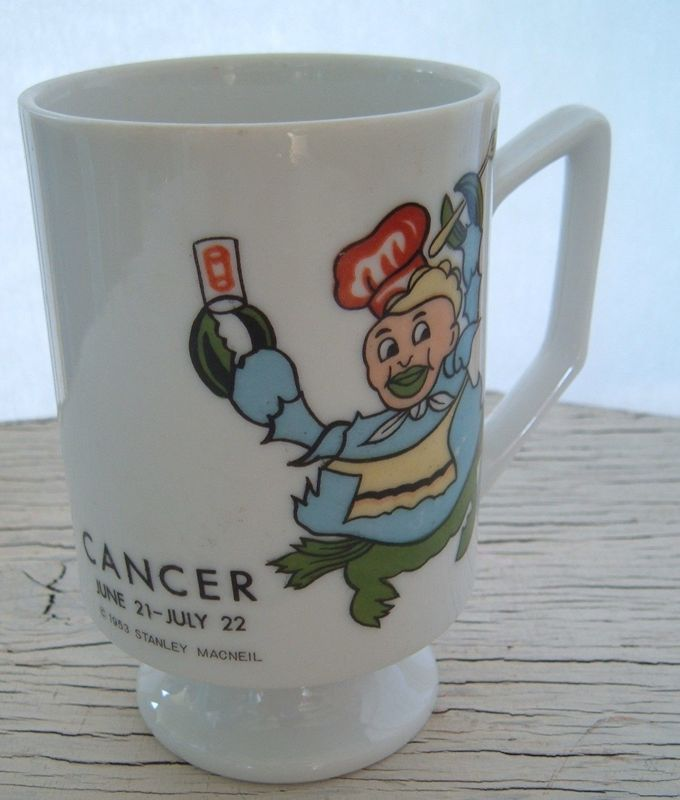 (image from ebay.com)
(image from ebay.com)
I also searched for some tiles in hopes of unearthing more images that would have appeared on the compacts, and I found some I couldn't find in compact form: Sagittarius, Scorpio and Pisces.
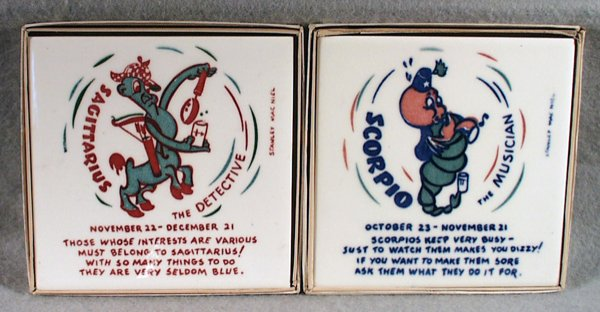 (image from liveauctioneers.com)
(image from liveauctioneers.com)
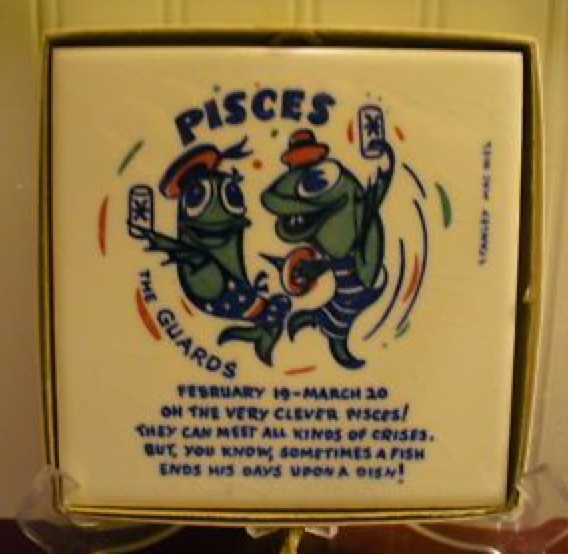 (image from pinterest.com)
(image from pinterest.com)
For the life of me though, sadly I couldn't find any images of Capricorn. I guess 11 out of 12 isn't bad, but that's going to drive me crazy. Hopefully one will surface eventually.
While I've figured out the release date of the compacts and a little more about the person behind the illustrations, I'm still not sure how the collaboration came about, i.e. whether MacNiel approached Elgin or the other way around. I also wonder whether he was an Aquarius, since the character for that sign seems to be Scottish (given the kilt and bagpipes) and is labeled as the "Connoisseur" while examining a drink in his hand. We know MacNiel was Scottish and considered himself a cocktail expert, since he mentions mixing "thousands" of drinks as research for his book, so perhaps the Aquarius fellow is meant to be a self-caricature. Unfortunately I can't find a date of birth anywhere for him. But overall, I was pleased with my detective work and I love these compacts, silly and cartoonish though they are. And MacNiel sounds like a hoot – I would have loved to have a drink with him.
What do you think of these? My collector's itch is definitely acting up and wants me to start hunting down all of them…if I ever come across a Scorpio one I'm going to pounce for sure!
About and History
Dedicated to the preservation, research and exhibition of cosmetics from antiquity through the 21st century, the Makeup Museum® is a progressive, unique space that explores makeup history, culture, design and packaging from all eras. The Makeup Museum is the first museum in the U.S. devoted exclusively to cosmetics and a leader in conceptualizing new ways of thinking about makeup and its cultural and artistic significance. Particular focus is given to previously hidden or little-known about histories and topics, offering an alternative account of makeup that challenges conventional narratives and highlights the voices of marginalized communities. Using an interdisciplinary approach that blends a variety of fields, especially material culture, art history, sociology, business, race and gender studies, the Makeup Museum offers a truly original perspective on makeup that goes beyond the canon.
In 2006, the Museum’s founder and curator had the idea to develop a coffee table book devoted to the most beautiful makeup from the 1990s and early 2000s. From that idea grew the bigger notion of an entire museum to display these objects, along with older pieces and a visual history of the makeup industry. In 2008 the Museum’s website was launched as a way to chronicle new makeup releases, research cosmetic objects and champion the idea of a dedicated cosmetics museum on a global scale. Over time the Museum evolved from a repository for well-designed makeup to a vital educational resource and agent for change.
The Makeup Museum is a 501 (c) (3) nonprofit organization and a member of the International Perfume Bottle Association, the British Compact Collectors Society, the American Alliance of Museums, and a co-founding member of the Cosmetics History and Makeup Studies Network.
Location and hours
There is no public physical space for the Museum yet, but private in-person tours of the collection can be arranged and admission is FREE! (Donations are greatly appreciated but certainly not expected.) As of September 2022, private in-person tours are no longer available due to COVID. But the magic of the internet means you can visit online 24/7. The collection as well as most exhibitions are displayed in the Curator’s Baltimore, Maryland home, while more in-depth exhibitions can be found here. Temporary/pop-up spaces are continually being explored. Subscribe to the blog feed or sign up for email updates for Museum news and announcements.
Museum Services and Inquiries
The Museum welcomes all inquiries. Please contact the Curator with any loan requests or photography permissions. The Curator is also available for press interviews, speaking engagements, consulting, research assistance, book contributions and other projects.
If you have an object you’d like to learn more about, please email the Curator with photos and any information you have. However, the Museum cannot provide valuations of artifacts. See the FAQ’s for details on object inquiries.
Mission Statement
The mission of the Makeup Museum is to:
– Preserve and document cosmetic objects from all eras and cultures for a variety of audiences: scholars, historians, makeup artists and enthusiasts, and the general public.
– Promote these objects as legitimate artifacts by examining the history, design, and artistic inspiration behind them.
– Explore the sociological and cultural impact of cosmetic artifacts, including their usage and advertising, along with makeup artistry and trends.
– Study and record the history of makeup, and serve as a worldwide research hub.
– Educate the public on the artistic, cultural, and historic value of makeup through exhibitions, publications, presentations, and workshops.
– Effect social change by displaying problematic artifacts and styles, discussing the harmful aspects of makeup history and beauty culture – both past and present – and recommending ways to take action.
Land Acknowledgement
The Makeup Museum is situated on the unceded ancestral land of the Susquehannock, Nentego (Nanticoke) and Piscataway peoples, now commonly known as Baltimore, MD. Please join the Museum in acknowledging the Native community, their elders both past and present, as well as future generations. The Makeup Museum recognizes the continued oppression of our country’s Native peoples and the role museums often play in this oppression. It also acknowledges the painful history of genocide and forced occupation of their territory, and that the Museum was founded upon exclusions and erasures of many Native peoples, including those on whose land this institution is located. This acknowledgement demonstrates a commitment to beginning the process of working to dismantle the ongoing legacies of settler colonialism. We strive to establish The Makeup Museum as an institute that develops and nurture positive relationships with the Indigenous peoples of this region as well as globally.
FY 2022 Annual Report
Download Makeup Museum FY 2022 annual report
Curious about the Makeup Museum? Hopefully this page will answer your queries!
Does the world really need a makeup museum? Why?
Of course! Makeup brings in trillions of dollars a year. Cosmetic history, styles and objects need to be researched and preserved to help us understand the industry’s enormous influence on society and effect change within it. On a superficial note, makeup is pretty to look at!
I found an old compact/lipstick/other beauty item. Can you identify it and/or tell me how much it’s worth?
I LOVE getting inquiries and researching them. I will do my best to identify the object and provide as much information as possible. However, as museums do not provide valuations, I cannot appraise the object’s monetary value. Also, I reserve the right to share your inquiry (I won’t use your name or any identifying information) and any pictures you might have at the Museum’s website, unless you ask me not to. Please understand that since I can’t devote all my time to the Museum, I’m not able to get back to you with an answer right away, but I always do respond eventually. And if you have any other beauty-related questions I’m happy to help with those too. I like to feel useful. Finally, researching inquiries is free, but donations are tremendously appreciated if you’re able. 🙂
Collecting makeup is weird. Aren’t you supposed to actually USE it? And won’t it go bad after a while anyway?
Well, collecting it isn’t so weird – no different than those who collect stamps or baseball cards. There are people who collect staplers, teabags and pencils so having a collection of makeup, relatively speaking, isn’t so strange. I must also point out that there are museums devoted to things like water, memes and mustard, so why not makeup?! As for it going bad, most of the items in the collection are powder-based, which can hold up for many years (provided you don’t drop them, of course.) If stored properly, cream and liquid-based items will last a long time as well. Frankly, since the objects aren’t being used, the issue of them going bad is moot.
So I get collecting the vintage stuff, but why contemporary makeup too?
Current makeup items are just as important as vintage as they tell us where the beauty industry is and where it’s going. They also speak volumes on contemporary views on not just makeup, but cultural and political values as well. If nothing else, new makeup will be vintage eventually, right?
Do you get any freebies from makeup companies?
Sadly, no. Nearly all of the objects in the Museum are paid for with my own hard-earned cash. Sometimes I receive items as gifts from friends and family, and I always acknowledge them as such. I’ve also been fortunate enough to receive some incredible donations from fellow makeup aficionados over the years. When I refer to the Museum’s “budget”, it really just means my own personal money that I’ve set aside for Museum acquisitions. If companies do ever want to throw free makeup at me, and I accept, I will definitely disclose it.
I’d love to work at the Makeup Museum! Any jobs available?
I appreciate your enthusiasm! And there’s nothing I’d like more than having a hard-working, dedicated (and ideally, well-paid) staff. But the Museum is currently a volunteer effort/labor of love on my part. I’m not employed or paid by the Museum – I have a completely unrelated full-time job, which I need so that I can afford to build the collection. Thus, there are no paid employment opportunities right now. However, if you’d like to volunteer, that would be amazing. I would fully credit you for your work and I may even be able to scrounge up a Sephora gift card in exchange for your help. 😉
I’m interested in purchasing some of the objects from the Museum. Would you sell them to me?
Apologies, but no. None of the Museum’s objects are up for deaccessioning at the moment.
 (images from etsy.com)
(images from etsy.com) 

 (image from onegiantyardsale.com)
(image from onegiantyardsale.com)
 (images from ebay.com)
(images from ebay.com)
 (image from ebay.co.uk)
(image from ebay.co.uk)

 (images from trifari.com)
(images from trifari.com)

 (image from ebay.com)
(image from ebay.com) (image from liveauctioneers.com)
(image from liveauctioneers.com) (image from pinterest.com)
(image from pinterest.com) 






